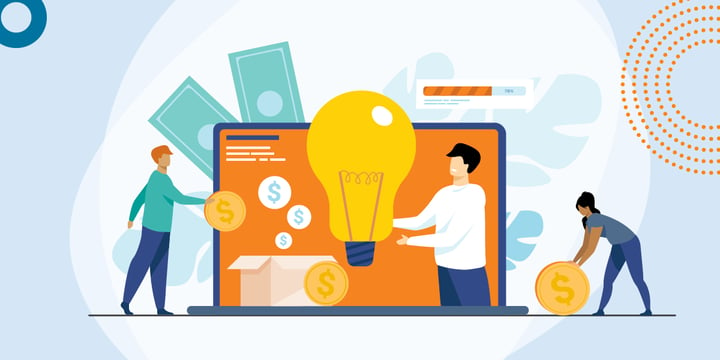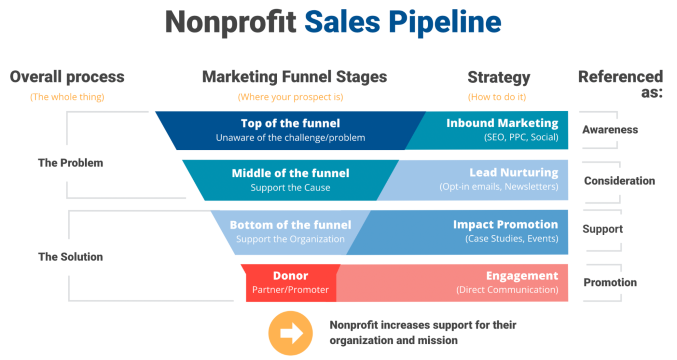On the surface, donors and customers seem totally different. One buys goods or services from a business, while the other gives money to an organization to support a cause. However, nonprofits could benefit from treating their donors or members like customers.

Attracting and converting potential donors can be complex and difficult. It's important to consider the road map your user takes from being a "stranger" to becoming an advocate for your organization. What should your nonprofit's "sales pipeline" look like? What are the best strategies you can use to connect your "customers" to your products and services? And what kind of content is going to be the most attractive, useful, and engaging to keep them happy and returning? Here are some best practices to use when applying sales strategies to nonprofit fundraising in order to build a network of passionate, loyal donors.
Applying the Sales Pipeline to Donors
A sales pipeline is a representation of how a potential customer — in the nonprofit case, a potential donor — moves through every stage of your sales process. A prospect moves through your pipeline by completing specific actions. When defining the stages of your nonprofit's sales pipeline, it's important to consider the overall process: the problem your organization supports and the solution your organization offers. Your prospect, first, needs to be aware of the problem your organization addresses. Then, they need to encounter the kind of content that will engage them to consider and decide to support the cause and the solution.
Your organization's donor journey should be based on your target audience, the desires and drives behind their decision-making, and how to inspire them in a personalized way. By implementing the inbound methodology and the full-funnel marketing framework, nonprofits can define four key stages of their sales pipeline: Awareness, Consideration, Support, and Promotion.

The Problem Your Organization Addresses
When looking at the full-funnel marketing framework, you can identify which stage of the pipeline your prospect is at. The top of the funnel and the middle of the funnel align within the Problem process. At the top of the funnel, you'll want to create engaging content for your prospect to become aware that the problem exists and that your organization works to tackle it. The prospect will then move to the middle of the funnel, where you will want to give them an incentive to consider supporting the cause.
Top of the Funnel: Awareness of Your Mission and Organization
Your potential donor is at the top of the funnel of your sales pipeline in the Awareness stage and is currently unaware of the problem your organization addresses. They are a stranger at this point, and this is your first greeting.
You first need to know who your target audience is and where they exist online. What's their communication preference? What drives their decision-making? Importantly, what are they passionate about? Once the target audience is clearly defined, nonprofits should leverage engaging, informative, and impactful content to drive traffic to their website. The messaging you use to attract your stranger should clearly identify the problem you solve, explain how you do your work, and describe the successful outcome.
Strategies for the Awareness stage:
- Blog posts: Write educational and impactful posts to inform and interest a potential donor who has not yet come into contact with your organization.
- SEO: Ensure that your website appears on searches related to your mission area.
- Social media: Consistently post accessible and current content related to your sector and the work you do within it.
- Infographics: You can use visuals to highlight statistics related to your cause.
- Videos: Engaging and impactful content shows your mission and outcomes. Testimonials are a great example.
- Referrals: Make sure others working in similar mission areas have a clear understanding of who you are, what you do, and who you support. Make it easy for them to send a potential donor your way.
Middle of the Funnel: Considering a Donation
Your potential donor is aware of the problem your organization supports and has funneled down to the Consideration stage. The stranger is now interacting with your organization through your website or social media.
It's your job to give them what they need to move towards the bottom of the funnel and make a donation. What tools or tactics can your website utilize to make your visitors want to support the cause? Is it easy for visitors to navigate your site and find the donation page? Do you have action-oriented content? What questions might your visitor have before making a decision, and can they easily find the answers on your website?
Strategies for the Consideration stage:
- Calls to action: Visible buttons throughout your website will help navigate a visitor to the donation page or to take intended steps towards it.
- Forms: Make it a clear and easy process for the visitor to donate and give them the option to commit to a recurring gift.
- Contacts: Make sure the information you collect from donors or prospective donors goes into a CRM or database so that you can efficiently follow up.
- Landing pages: Create clear, action-oriented copy and clean designs to ensure that the path to donation is easy to navigate.
- Donation platform: Use a donation platform with a simple interface, multiple ways to donate, and a trusted, secure online process.
Showing the Solution You Offer
In the Solution process, your prospect will move down to the bottom of the funnel stage, before finally becoming a donor. In the bottom of the funnel and "customer" stages, the prospect needs to be convinced of the value of your organization and why they should contribute to it.
Bottom of the Funnel: Supporting Prospective Donors
Potential donors have made it to the bottom of your funnel and are now seriously considering donating. How do you maintain and nurture the relationships you built? You should remove as much friction as possible and encourage them to take the final steps to donate. You'll need clear, informative copy that highlights the solution your organization offers and convinces the person that their contribution contributes to your impact.
Strategies for the Support stage:
- Contact relationship management (CRM) software: Understand and maximize your relationships with donors.
- Email: Build trust, show donors how you are using their gift, and stay top-of-mind.
- Website analytics: Understand how users navigate your website and enhance your strategy accordingly.
- Marketing automation: Encourage your potential donors to take that final step through automated campaigns.
Customer: Promotion
They made a donation! You did it. However, the sales process is not over. There are plenty of opportunities to reengage your donors and encourage them to be further involved with your work. Content in the Promotion stage should be personalized and explicit and include deeper reasons why the customer should continue to donate or get involved in other ways.
Strategies for the Promotion stage:
- Smart calls to action: Customize the goal or offer on a page to consider where in the life cycle a contact is. That person who just donated should see a CTA encouraging them to commit to a recurring donation.
- Social monitoring: Track mentions, tags, or responses to your organization on social media and keep control of messaging while being responsive to questions or concerns. Make donors feel like they are part of your organization.
- Surveys: Gather feedback on your website, donation platform, and other crucial steps in guiding a person towards making a gift.
Using Sales Strategies to Increase Donations
It might feel unusual to leverage corporate sales strategies in nonprofit fundraising. However, nurturing leads in this way helps you to find people who are already invested in your mission area and show them what you do and how their gift can help. Guiding potential donors using sales techniques enables you to identify those who are already looking to put their money somewhere meaningful and teach them why your nonprofit is a great choice.
Additional Resources
- Take advantage of TechSoup's Digital Marketing Services.
- Learn about Building a Donation Funnel Using Your Organization's Website.
- Sign up for TechSoup Courses' Fundraising for Nonprofits track.
- See a webinar on How to Grow and Engage Your Donors, Members, and Volunteers.
Top photo: Shutterstock








